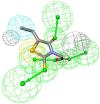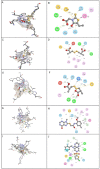Identification of Putative Plant-Based ALR-2 Inhibitors to Treat Diabetic Peripheral Neuropathy
- PMID: 35877418
- PMCID: PMC9319673
- DOI: 10.3390/cimb44070194
Identification of Putative Plant-Based ALR-2 Inhibitors to Treat Diabetic Peripheral Neuropathy
Abstract
Diabetic peripheral neuropathy (DPN) is a common diabetes complication (DM). Aldose reductase -2 (ALR-2) is an oxidoreductase enzyme that is most extensively studied therapeutic target for diabetes-related complications that can be inhibited by epalrestat, which has severe adverse effects; hence the discovery of potent natural inhibitors is desired. In response, a pharmacophore model based on the properties of eplarestat was generated. The specified pharmacophore model searched the NuBBEDB database of natural compounds for prospective lead candidates. To assess the drug-likeness and ADMET profile of the compounds, a series of in silico filtering procedures were applied. The compounds were then put through molecular docking and interaction analysis. In comparison to the reference drug, four compounds showed increased binding affinity and demonstrated critical residue interactions with greater stability and specificity. As a result, we have identified four potent inhibitors: ZINC000002895847, ZINC000002566593, ZINC000012447255, and ZINC000065074786, that could be used as pharmacological niches to develop novel ALR-2 inhibitors.
Keywords: ADMET; NuBBEDB; molecular docking; pharmacophore; structure-based drug design.
Conflict of interest statement
The authors declare no conflict of interest.
Figures





Similar articles
-
C ucumis melo compounds: A new avenue for ALR-2 inhibition in diabetes mellitus.Heliyon. 2024 Jul 27;10(15):e35255. doi: 10.1016/j.heliyon.2024.e35255. eCollection 2024 Aug 15. Heliyon. 2024. PMID: 39170458 Free PMC article.
-
Virtual screening of epalrestat mimicking selective ALR2 inhibitors from natural product database: auto pharmacophore, ADMET prediction and molecular dynamics approach.J Biomol Struct Dyn. 2022 Aug;40(13):6052-6070. doi: 10.1080/07391102.2021.1875878. Epub 2021 Jan 22. J Biomol Struct Dyn. 2022. PMID: 33480327
-
Synthesis and biological evaluation of new epalrestat analogues as aldose reductase inhibitors (ARIs).Eur J Med Chem. 2014 Jan;71:53-66. doi: 10.1016/j.ejmech.2013.10.043. Epub 2013 Nov 6. Eur J Med Chem. 2014. PMID: 24275248
-
Development of Novel Indole-Based Bifunctional Aldose Reductase Inhibitors/Antioxidants as Promising Drugs for the Treatment of Diabetic Complications.Molecules. 2021 May 12;26(10):2867. doi: 10.3390/molecules26102867. Molecules. 2021. PMID: 34066081 Free PMC article. Review.
-
Natural Compounds as Source of Aldose Reductase (AR) Inhibitors for the Treatment of Diabetic Complications: A Mini Review.Curr Drug Metab. 2020;21(14):1091-1116. doi: 10.2174/1389200221666201016124125. Curr Drug Metab. 2020. PMID: 33069193 Review.
Cited by
-
Combining Network Pharmacological Analysis and Animal Experiments to Explore the Pharmacological Mechanism of Zhangyanming Tablets in Diabetic Retinopathy.Diabetes Metab Syndr Obes. 2025 Apr 28;18:1323-1339. doi: 10.2147/DMSO.S495286. eCollection 2025. Diabetes Metab Syndr Obes. 2025. PMID: 40321675 Free PMC article.
-
Utilizing ADMET Analysis and Molecular Docking to Elucidate the Neuroprotective Mechanisms of a Cannabis-Containing Herbal Remedy (Suk-Saiyasna) in Inhibiting Acetylcholinesterase.Int J Mol Sci. 2025 Mar 29;26(7):3189. doi: 10.3390/ijms26073189. Int J Mol Sci. 2025. PMID: 40243991 Free PMC article.
-
Peptidomimetics for CVD screened via TRADD-TRAF2 complex interface assessments.In Silico Pharmacol. 2023 Oct 27;11(1):28. doi: 10.1007/s40203-023-00166-0. eCollection 2023. In Silico Pharmacol. 2023. PMID: 37899969 Free PMC article.
-
Role of Alkannin in the Therapeutic Targeting of Protein-Tyrosine Phosphatase 1B and Aldose Reductase in Type 2 Diabetes: An In Silico and In Vitro Evaluation.ACS Omega. 2024 Aug 18;9(34):36099-36113. doi: 10.1021/acsomega.4c00082. eCollection 2024 Aug 27. ACS Omega. 2024. PMID: 39220541 Free PMC article.
-
C ucumis melo compounds: A new avenue for ALR-2 inhibition in diabetes mellitus.Heliyon. 2024 Jul 27;10(15):e35255. doi: 10.1016/j.heliyon.2024.e35255. eCollection 2024 Aug 15. Heliyon. 2024. PMID: 39170458 Free PMC article.
References
-
- Yang H.-Y., Li Q.-R., Wang Z., Zhou W., Fan S.-R., Ma R., Xue L., Yang L., Li Y.-S., Tan H.-L., et al. Epalrestat protects against diabetic peripheral neuropathy by alleviating oxidative stress and inhibiting polyol pathway. Neural Regen. Res. 2016;11:345–351. doi: 10.4103/1673-5374.177745. - DOI - PMC - PubMed
Grants and funding
LinkOut - more resources
Full Text Sources
Research Materials
Miscellaneous

